Christian W. Staudinger
Christian W. Staudinger (born December 19, 1952, in Erfurt, East Germany) is a German artist who became involved in art after his escape from the GDR and the trial of a civil life. He is dedicated to the visual arts (sculpture and painting), performance and conceptual art, poetry and political arts,[1] is a video artist and arranges installation art.
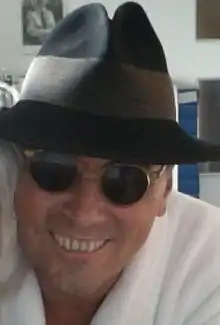
Life
Childhood in Waltershausen (1952–1968)
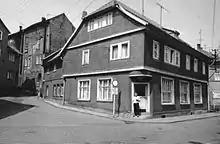

Staudinger was the son of a hotel and restaurant manager, Gerhard Staudinger (b. April 20, 1923, in Erfurt, d. February 3, 1988, in Waltershausen), and his wife Edeltraut (b. January 30, 1927, in Wandersleben, d. December 11, 2011, in Waltershausen). He grew up in the village of Schmira near Erfurt and from 1956 in Waltershausen, where his parents ran the Bayerischer Hof restaurant, a member of the state-controlled Restaurant Trade Organisation (German: HO). In Schirma they ran the Hotel Welcome, a private, independent business, but in 1956, about the time when Christian's brother Ulrich was born, they moved to the state-controlled hotel in Waltershausen, as they had to give up their independent operators' license. Staudiger had a happy childhood although there were arguments with his parents about politics. His parents were still influenced by the politics of the Nazi era, and were extremely critical of the GDR. The national flag was not flown when it was required to be and his parents never voted in GDR elections, although these were both officially required duties in the GDR. However, members of the Stasi hierarchy visited his parents' restaurant because of the good food. Christian Staudinger was an enthusiastic communist, avidly read communist literature, and was a keen drummer in the local marching band in Waltershausen, guided by his teacher Otto Müller.
His paternal grandfather, Wilhelm Staudinger, was a German nationalist, who ran Hotel Welcome with his wife Paula, before his son took over. During the Nazi period he gave extra bread and milk to forced labourers. The village teacher betrayed him. He was arrested, tortured at Petersberg Citadel in Erfurt and died a few days later as result. Staudiger's maternal grandfather, Phillip Orth, worked for the German Railways and co-founded the Communist Party of Germany in Neudietendorf shortly after the First World War. To protect the family, he sent his daughter to the League of German Girls, a Nazi organisation. He was not bothered by the Nazis and died when Staudinger was 16 years old. His uncle, Sigmar Orth, was a liaison officer between the police and the Stasi, who encouraged Staudiger's interest in history and enthusiasm for the developing communist German state.
Youth and escape from East Germany (1968–1972)
At age 16, Staudinger left home and went to Erfurt, where he began his apprenticeship as a waiter after his original career aspirations of being a sailor in the merchant navy and, thereafter, the boatman on inland waters had been rejected by the Stasi. People in the GDR needed a permit from the state for their career aspirations. In Erfurt he fell into circles around Eberhard Häfner and others.[2] They had passionate discussions about politics and art, listened to the music of the so-called imperialist Staatsfeind and he came in contact with THC and LSD-25. He read Group Psychology and the Analysis of the Ego and Totem and Taboo by Sigmund Freud, which he had received from Eberhard Häfner. He tried to use these writings in his final examination paper—then viewed as an affront. His teacher, Mrs. Richter, expressed her enthusiasm privately but could not vote because literature of the "State-enemy" had been cited. The day after his practical test, from which he made a parody and therefore failed, Staudinger went to escape from East Germany. He wished to leave his beloved home, because emerging and fast growing doubts about the integrity of the system were growing in him. He had read the classics, but all that did not stand in comparison with reality. In addition, he wanted to become a skydiver. He was in the Gesellschaft für Sport und Technik, but in order to jump one had to be in the National People's Army or in the Stasi. The Stasi began to be interested in him and tried to recruit him as part of the OPK (operational checks on persons). He felt honoured and loved those discussions with the Stasi officers who at home always encountered violent counter-arguments. But soon the Stasi was tired, wanted names that he refused to provide, prompting the never-forgotten threat received by many former GDR-citizens: "Either you are with us or against us. Join in and out you can be something. If not, you will croak on the machine!"

At the age of 18, in 1971, Staudinger and a friend made their way to Bulgaria in order to leave the country to travel to Turkey. This was the route many so-called “Republic-refugees” had chosen, as Stefan Appelius,[3] a professor of Political Science, has researched. Only his brother was informed he was leaving so as not to endanger the family. At the Veleka river[4] they failed to escape because the maps were wrong.[5] They were arrested and tortured[6] and put in a Bulgarian prison. But Staudinger lived, unlike other refugees.[7] The Stasi in Bulgaria brought him back to East Germany, and he was put into the Stasi prison, Andreasstrasse,[8] in Erfurt and sentenced to one year and seven months for his attempt at illegal emigration and fomenting anti-state-propaganda, which he served in Cottbus. With the help of the two lawyers Vogel & Stange (one east, one west, and in that time famous in Germany) he came straight from prison to the Federal Republic of Germany. By a tragic event, unlike many others in the GDR convicted for political offenses, came into possession of copies of the indictment[9] and judgment.[10] The experiences of the flight are published in German as an audio book on YouTube,[11] spoken by Erich Räuker.[12] Shortly before his flight Staudinger had fathered a child, which he learned about in prison after it was born. He managed to bring the mother and child using of family reunification to West Berlin. The West and the events of the recent past destroyed everything he had believed, so that he tried to kill himself in 1974 with 250 sleeping pills. The doctors succeeded in saving him from being clinically dead. His brother, Ulrich,[13] later was sentenced to 4 years for reportedly subversive propaganda. Released earlier he jumped to jumped to his death in a West Berlin subway 1981.[14]
Adult in Berlin (since 1972)
Having found accommodation in the Evangelisches Johannisstift in Berlin, Pastor Helmut Gwiasda[15] took him under his wing. He let Staudinger complete the diaconal basic course,[16] but it drove him on. He went to high school and then studied social pedagogy and philosophy. His own prison experience influenced him professionally and between 1981–1986 he worked in the women's prison in Berlin as a group leader with drug-addicted adult women. Severe migraine attacks forced him to give up. He then moved to the creative arts. His efforts to become member of the Professional Association of Visual Artists in Berlin (BBK)[17] failed—he was rejected because he did not want to be confined to the visual arts. He responded with a public debate in the former Open Channel Berlin, known today as AlexTV.[18] The connection between art and sport is important to Staudinger.[19] In 1977 he went to Texel (Netherlands) and completed his training as a parachutist and 1992 in DeLand, Florida as a jumpmaster.
Artistic career
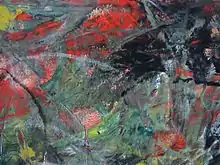

The first abstract paintings were created when he was no more than ten years old—he called them children's work.[20] Three representational paintings from this period with the titles The LPG, Klaustor and Moon landing were exhibited at a school in Waltershausen but never returned, and have been lost since the change 1989/90. Russian drawing teacher Thiem promoted his artistic talent and looked after the missing talent for foreign languages. His father, who was an enthusiastic amateur photographer, introduced him to photography and filming. He used Super 8 film and recorded Staudinger's childhood which is well documented. Staudinger sold his first pictures at school and accumulated in pocket money, managed by his mother. He burned some of it in the context of his first performance outside the Theater of Friendship in Waltershausen. In his school the artist was in the Committee Film in the Theater of Friendship from the fifth to the tenth grade.[21] In 1968 he wrote his first poems.[22] The illegal West TV in his parents home introduced Staudinger to Joseph Beuys and he read the GDR banned authors like Erich Fromm, Sigmund Freud, Laozi, Nietzsche, C.G. Jung and others.[23]
In 1980 he moved to his first tiny painting studio in Berlin. He worked initially as self-taught, and was again, as in his childhood, a bookworm.[24] In 1981, shortly after the beginning of his work in the prison, at the former Landesbildstelle Berlin he took a video course and applied thereafter for the first time at the German Film and Television Academy Berlin (dffb).[25] His application was unsuccessful. In 1983 he founded the publishing company Zwielicht[26] and published his two volumes of poetry Zustände eines Grenzverletzers[27] and Über mir bin Es.[28] In the same year he first took part (and from then on every year) in the Free Berlin Art Exhibition (in German FBK) under the leadership of Ernst Leonhardt.[29] [30] He was member of the group of artists known as Blindflug[31] which was led by Norbert Wirth.[32] Later he joined the FBK as an individual artist.
In 1986 his main occupation as an artist began and with his participation in the Open Channel Berlin–today AlexTV.[33] In the following eight years, there have been numerous artistic projects, first performances and the development of conceptual art.[34] Some videos were posted on the Hamburg short-film-festival, while others were presented at the Tokyo International Film Festival, including Die Mutter, Revolution and Heimat.[35] In 1994, Staudinger took part in the Artistic Competition Memorial to the Murdered Jews of Europe[36] and started at the Free Art School in Berlin to study screen printing and sculpture, which he later continued with Peter Rosenzweig[37] in Campo dell'Altissimo.[38] In 2005 he stood as a witness for injustice in the GDR at [39] Erfurt of Hildigund Neubert. This led to an artistic action in his former cell in the Andreasstrasse Stasi prison in Erfurt.[40] In the meantime he moved twice with his painting-studio to larger ones, and two sculptor-studios in Berlin and Waltershausen were established. In 2007 he presented to the public the results of his 10-year work on Nazism and Adolf Hitler under the title Adolf Hitler 007[41][42] He was under police protection, but except for a small event announcement,[43] coverage by the media wasmuted. In 2008, his dispute with the second German dictatorship in the GDR began under the title Prison & Torture in Bulgaria and the GDR. Two exhibitions were the outcome in 2014 in Erfurt, one in the former prison[44][45] and one in Speicher in Erfurt.[46][47] There are plans for an ArtHouse Waltershausen in the house of his parents in Thuringia.
Artistic works
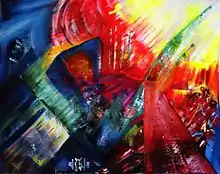

Staudinger's artistic work includes paintings[48] in different styles, formats and techniques, drawings,[49] collages,[50] etchings, crayon, silkscreen, watercolors[51] and BookArt[52]—i.e. drawings that are created when reading in books and influenced by what is read. There are also sculptures,[53] statuettes[54] and applied art,[55] as well as installation art and assemblages. A large room holds the political art[56] using their confrontation with the two German dictatorships. There is an extensive archive with conceptual art[57] and some is in a field—Land art—under the title Stones of the Earth.[58] The work includes natural and artificial photos,[59] as well as poetry and postcards.[60] Video works[61] often accompanies other artistic projects by Staudinger and documents them or is shown with accompanying performances. The covers for DVDs are designed and manufactured by hand. Lately they are, often greatly reduced, posted on his YouTube channel.[62]
Releases
Books
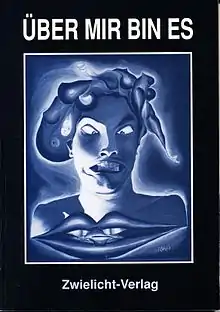
Filmography


All short videos up to 2011 were published in full-length (40–120 min.) in the Open Channel Berlin (OKB, today AlexTV).
Cutouts:[63]
|
|
Exhibitions
Cutouts:
- 1964: Polytechnische Oberschule Waltershausen/GDR,[65] group-exhibition
- 1983–1995: Freie Berliner Kunstausstellung – annual participation[66]
- 1986: Offener Kanal Berlin/AlexTV – ongoing publishing of art-videos
- 1987: Galerie Goltzstr. 32, Berlin[67]
- 1987: Die Anweisung[68]
- 1989: Kunsthaus Lütjenwestedt, Schleswig-Holstein[69]
- 1991: Gesinnungstat Kunst, Mediathek Köpenick[70]
- 1995: Denkmal für die ermordeten Juden Europas, Berlin[71]
- 1996: KunstKaos in Köpenick[72]
- 1998: Erdensteine, Sinai – ongoing public exhibition[73]
- 1999: Abstraktionen, Museum für Leben & Kunst, Berlin[74]
- 2001: Camera obscura, Wuhlheide Berlin[75]
- 2002: Köpfe & Abstraktionen, Edenhaus am Europacenter, Berlin[76]
- 2007: Adolf Hitler 007 – Unerträgliches ertragen , Berlin[77]
- 2014: so nah...weit fern – group-exhibition in Erfurt[78]
Performances

Cutouts:[79]
- 1988: Die Mauer muss weg
- 1988: Hommage an Joseph Beuys
- 1991: Kunstaktion IFA91
- 1994: Das Bild sind Sie selbst
- 1997: Hommage an die Christo's
- 1997: Soma
- 2013: MACHT BANK KUNST ???
References
- political arts
- Independent literature in the GDR
- more about refugees from GDR over Bulgaria at Stephan Appelius
- The Veleka on YouTube: Video of the place of arrest where many refugees from GDR failed
- More about fake maps at Planet Wissen
- More about arrest & torture of the artist
- Tod in Bulgarien. Bouvier Verlag, Bonn 2007
- Stasi prison Andreasstrasse
- staudinger's indictment
- Staudinger's Judgment
- Audiobook on YouTube about the experiences of Staudinger in his flight (in German)
- Erich Räuker, voice actor – see also his official website and his personal website
- Brother Ulrich
- Ulrich's death, see also Video
- Helmut Gwiasda: Demokratie – eine christliche Staatsform. Kreuz-Verlag 1987
- See also Deacon
- see also website of BBK
- see also Website of AlexTV
- see for instance Staudinger's project Art & Sport
- children's work by Staudinger
- Staudinger and the Theater of Friendship/Waltershausen, including poster of Spur der Steine
- Staudinger's volumes of poetry, see also here and following sites
- Independent literature in the GDR
- see Staudinger's BookArt, and also Video BookArt
- see also website of the dffb Archived June 8, 2014, at the Wayback Machine
- Zwielicht-Verlag
- Christian Staudinger: Zustände eines Grenzverletzers. Gedichte und Zeichnungen. Zwielicht-Verlag, Berlin 1983 ISBN 3-924031-00-2, see Deutsche Nationalbibliothek
- Christian Staudinger: Über mir bin Es. Gedichte Zeichnungen Collagen Fotos. Zwielicht-Verlag, Berlin 1989 ISBN 3-924031-01-0, see Deutsche Nationalbibliothek
- see also website of Ernst Leonhardt
- here
all catalogs without disclosing publisher and editor, but seen under “1983–1995 participation in FBK” in MLK
Catalog: 13. Freie Berliner Kunstausstellung 1983, pp. 88–90.
Catalog: 14. Freie Berliner Kunstausstellung 1984, pp. 72–75.
Catalog: 15. Freie Berliner Kunstausstellung 1985, pp. 87–89.
Catalog: 16. Freie Berliner Kunstausstellung 1986, pp. 83–85.
Catalog: 17. Freie Berliner Kunstausstellung 1987, pp. 85–87.
Catalog: 18. Freie Berliner Kunstausstellung 1988, pp. 82–84.
Catalog: 19. Freie Berliner Kunstausstellung 1989, p. 91.
Catalog: 20. Freie Berliner Kunstausstellung 1990, pp. 91–93.
Catalog: 21. Freie Berliner Kunstausstellung 1991, p. 79.
Catalog: 23. Freie Berliner Kunstausstellung 1993, pp. 10 + 163.
Catalog: 24. Freie BerlinerKunstausstellung 1994, p. 111.
Catalog: 25. Freie Berliner Kunstausstellung 1995, p. 149 + 235. - about the group Blindflug there is almost nothing on the net except here under “1983–1995 participation in FBK”
- "Norbert Wirth". Archived from the original on December 8, 2015. Retrieved December 3, 2015.
- see also website of AlexTV
- see Staudinger's conceptual art
- for example: Die Mutter, 1996, BRD, 15 Min. In: Anke Schwede (Hg.): Verzeichnis Dokumentarvideo 96. querblick 1997, p. 55, ISBN 3-931731-34-0. Apart from that, both the Hamburg short-film-festival and Tokyo International Film Festival do not call all the participants or the archives are not far enough back.
- see website of the foundation Memorial to the Murdered Jews of Europe. Unfortunately, there are neither there nor in another place in the network, the names of the 528 participants in the artistic competition. See also: Holocaust Memorial in Berlin and The artist's contribution
- Website of Peter Rosenzweig
- Campo dell' Altissimo
- Land Commissioner Thüringen for the Stasi records
- read more about that place at the Foundation Ettersberg
- Art exhibition Adolf Hitler 007
- Video documentation of the vernissage on YouTube
- Event Note of the exhibition Adolf Hitler 007 in Tagesspiegel, there under “Tegeler Weg 104”
- see Andreasstrasse under October 3
- Documentation of the exhibition with photos & videos
- see website of Speicher in Erfurt
- Documentation of the exhibition with photos & videos
- Art Gallery
- Drawings
- Collages
- Etchings, crayons, silkscreens, watercolors
- BookArt
- Sculptures
- Statuettes
- Objects
- PoliticalArt
- Conceptual art
- Stones of the earth
- Photo gallery
- Poetry & postcards
- Video works
- Staudinger's YouTube-channel
- Staudinger's YouTube-channel
- KunstKaos in Köpenick
- Exhibitions & releases
- Flyer & posters 1983–95 Freie Berliner Kunstausstellung
- Flyer & posters 1987 Galerie Goltzstr. 32
- Flyer & posters 1987 Die Anweisung
- Flyer & posters 1989 Kunsthaus Lütjenwestedt
- Flyer & posters 1991 Mediathek Köpenick
- Memorial
- KunstKaos
- Stones of the earth
- Exhibitions & releases
- Camera obscura
- Flyer & posters 2002 Köpfe & Abstraktionen
- AH 007
- Exhibition so nah...weit fern
- Playlist performances
External links
| Wikimedia Commons has media related to Christian W. Staudinger. |